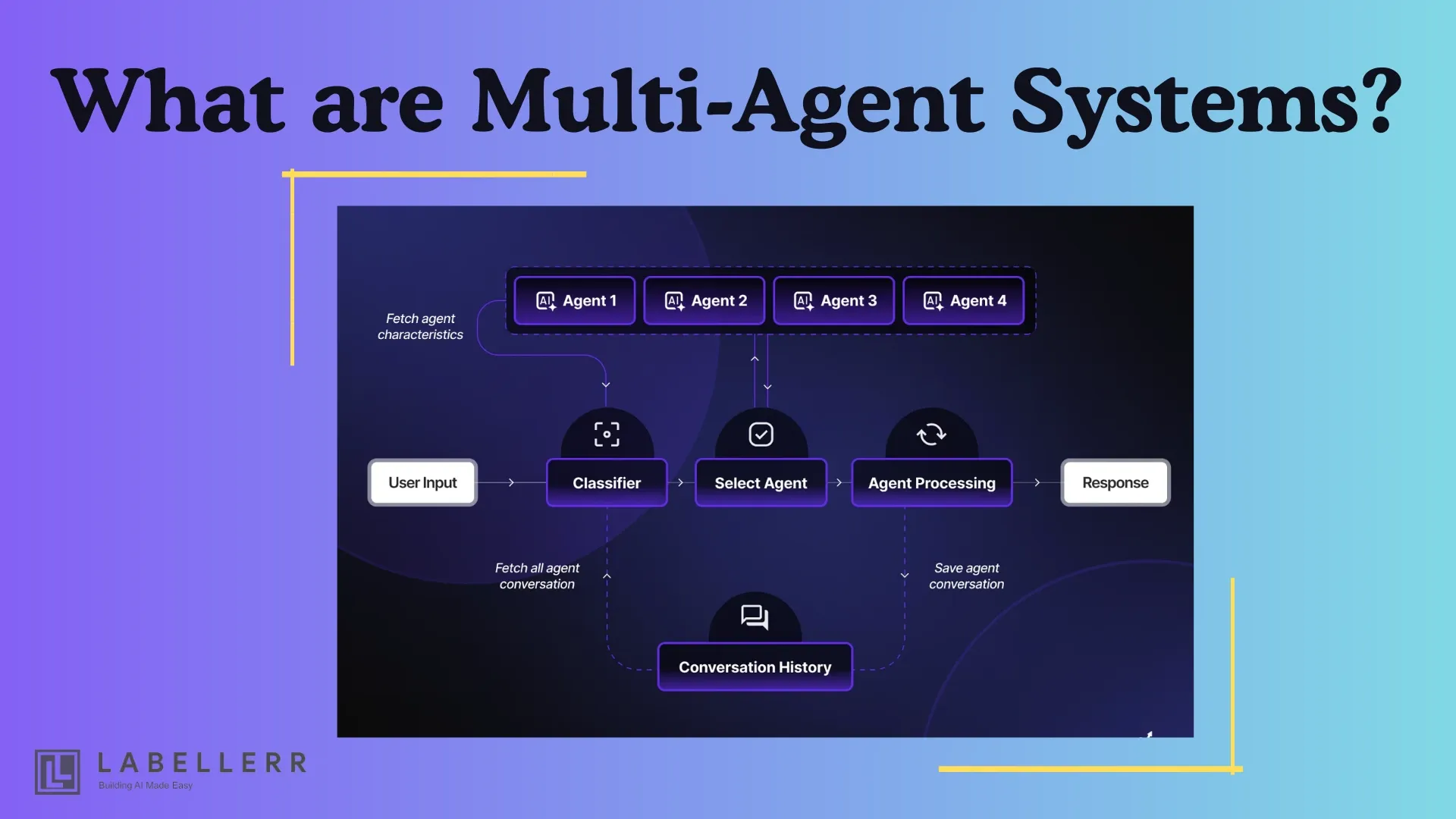What are Multi-Agent Systems? A Beginner's Guide
Multi-Agent Systems (MAS) use multiple smart agents that sense, decide, and act independently while working together. Unlike traditional AI, they adapt quickly, scale easily, and power real-world solutions from traffic control to healthcare and e-commerce.

In the early days, most tasks were handled either manually by humans or through single, centralized systems. While this worked for simple problems, it became difficult as tasks grew more complex and required faster decision-making.
Humans working in teams could collaborate, but they often faced issues like delays, errors, and limited scalability. On the other hand, traditional systems lacked flexibility and couldn’t easily adapt to dynamic environments.
This is where Multi-Agent Systems (MAS) come in as a solution. Instead of relying on one system or manual teamwork, MAS uses multiple intelligent agents that can work together, interact with their environment, and achieve specific goals more efficiently.

Multi-Agent System
What is an Agent?
Before we understand Multi-Agent Systems, let’s first look at what an agent actually is. An agent is a small, intelligent, and autonomous unit that can sense changes in its environment, make decisions, and take actions based on those changes.
Example: A chatbot that answers your questions. It listens to what you ask, understands it, and responds with the right answer. Similarly, agents automate tasks by reacting and acting intelligently.
You might ask: ''Why prefer agents when traditional AI models can perform similar tasks?'' The difference lies in their key capabilities that make them more adaptive and efficient. These capabilities allow agents to adapt to changes, coordinate with others, and handle complex, dynamic environments—something traditional AI models may struggle with.
- Reactivity: Agents sense their environment and respond appropriately.
- Proactivity: They don’t just wait to react—they can take initiative to achieve goals.
- Autonomy: Agents operate without constant human guidance.
- Collaboration: They can interact and cooperate with other agents to handle complex tasks.
These capabilities allow agents to adapt to changes, coordinate with others, and handle complex, dynamic environments—something traditional AI models may struggle with.
What are Multi-Agent Systems?
A Multi-Agent System (MAS) is a collection of agents that interact with each other as well as with their environment to achieve a defined goal.
To better understand this, consider the example of a self-driving car. Imagine a car as an agent that can sense directions and obstacles, navigating safely to its destination. When multiple self-driving cars communicate and coordinate with each other, they can manage traffic more efficiently, avoid congestion, and reduce the risk of accidents. This is a real-life example of a Multi-Agent System in action.
MAS vs Traditional AI
Traditional AI models usually do one task at a time and work independently. They can perform their jobs well but often have trouble adapting when things change or working together with other systems.
Multi-Agent Systems (MAS), on the other hand, have many smart agents that can observe their surroundings, make decisions on their own, and work together. This helps MAS handle changing and unpredictable situations much better.
For example, in a CCTV surveillance system, a traditional AI might just spot an event and send an alert. An agent-based system, however, can have multiple agents watching different cameras, talking to each other, checking for real problems, and coordinating responses in real-time. This reduces false alarms and makes the whole system more efficient. MAS are better at adapting, working together, and handling errors in complex real-world situations.
Architecture of Multi-Agent Systems
The architecture of Multi-Agent Systems (MAS) can be broadly categorized into three main types:
- Centralized architecture: In this architecture, a central hub connects and monitors all agents to ensure smooth workflow. While coordination is easier, failure of the central hub can lead to the collapse of the entire system.
- Decentralized architecture: Here, agents share information only with their neighboring agents instead of relying on a central hub. This reduces the risks associated with a single point of failure, but coordinating multiple agents can be more challenging.
- Hybrid architecture: This combines elements of both centralized and decentralized architectures, aiming to leverage the benefits of each while minimizing their respective drawbacks.

Architecture Types
Real-Life Examples of Multi-Agent Systems
With the ease of multi-agents systems, we are able to solve complex problems easily. Some of the domains where they are applicable are:
- Transportation: Imagine a busy city with hundreds of vehicles on the road. If each traffic light worked independently, there would often be jams and long waiting times. But when traffic lights act as agents and communicate with each other, they can coordinate to allow smooth traffic flow.
For example, if one signal detects heavy traffic on a road, it can inform the next signal to adjust its timing. This coordination helps reduce congestion, saves fuel, and improves overall traffic management. - Healthcare: In modern hospitals, patients are often connected to monitoring devices that track vital signs like heart rate, blood pressure, and oxygen levels. Each of these devices can act as an agent.
When combined into a Multi-Agent System, they can share data in real-time with doctors and even suggest possible treatments. For instance, if a patient’s oxygen level drops suddenly, the system can alert the doctor immediately and also suggest potential interventions. This makes patient care faster, smarter, and more reliable. - E-commerce: Online shopping platforms like Amazon rely heavily on agent-based systems. Buyer agents track user preferences, search for the best deals, and recommend products.
At the same time, seller agents manage stock availability, pricing, and delivery schedules. These agents negotiate in the background to make sure that buyers get the best price and fastest delivery while sellers maximize their sales.
For example, when you add an item to your cart, buyer and seller agents might quickly adjust availability and recommend complementary products, making the whole experience seamless.
Advantages
- Scalability: Adding more agents makes it easier to handle larger and more complex problems.
- Specialization: Each agent can focus on a specific task, improving efficiency.
- Robustness: The overall system remains stable and reliable even if some agents face issues.
Disadvantages
- Complexity: Designing agents can be challenging, particularly because they need to interact, cooperate, and sometimes compete, which requires careful management of communication protocols and conflict resolution.
- Unpredictable behavior: Each agent operates independently, so the overall behavior of the system can be difficult to predict and may sometimes be unexpected.
- Lack of Standardization: The absence of universal standards for communication, coordination, and behavior modeling makes integrating agents from different sources difficult.
Open-source MAS Frameworks
Building a Multi-Agent System from scratch can be a complex task, especially if you are a beginner. Open-source frameworks make this easier by giving you ready-made tools, so you don’t need to code everything manually.
Some of the widely used frameworks are:
- CrewAI – Lets multiple agents work together to solve problems.
- LangGraph – Helps create step-by-step workflows where agents coordinate.
- Phidata – A lightweight and simple framework to integrate agents into real-world applications.
Hands-on tutorial:
Let’s see MAS in action! In this simple example, different agents move independently on a grid, demonstrating interaction, autonomy, and awareness.
Step 1: Install mesa
Mesa is a popular and most commonly used Python library used for agent-based modeling (ABM).
pip install mesa==2.3.2
Step 2: Create Python File and paste the below code
from mesa import Agent, Model
from mesa.time import RandomActivation
from mesa.space import MultiGrid
from mesa.visualization.modules import CanvasGrid
from mesa.visualization.ModularVisualization import ModularServer
# Define a simple agent
class SimpleAgent(Agent):
def __init__(self, unique_id, model):
super().__init__(unique_id, model)
def step(self):
# Move to a random neighboring cell
possible_steps = self.model.grid.get_neighborhood(self.pos, moore=True, include_center=False)
new_position = self.random.choice(possible_steps)
self.model.grid.move_agent(self, new_position)
# Define the simulation model
class SimpleMAS(Model):
def __init__(self, N=5, width=5, height=5):
self.num_agents = N
self.grid = MultiGrid(width, height, torus=True)
self.schedule = RandomActivation(self)
for i in range(self.num_agents):
a = SimpleAgent(i, self)
self.schedule.add(a)
x = self.random.randrange(width)
y = self.random.randrange(height)
self.grid.place_agent(a, (x, y))
def step(self):
self.schedule.step()
# How agents look on the grid
def agent_portrayal(agent):
return {"Shape": "circle", "r": 0.5, "Color": "blue", "Layer": 0}
# Create grid visualization
grid = CanvasGrid(agent_portrayal, 5, 5, 500, 500)
# Launch the server
server = ModularServer(SimpleMAS, [grid], "Simple Multi-Agent System", {"N": 5, "width": 5, "height": 5})
if __name__ == "__main__":
server.launch()
Step 3: Run the Simulation
python .py
The above code will open a browser window displaying a 5x5 grid with 5 blue dots, each representing an agent. These agents move independently and randomly, demonstrating key features of Multi-Agent Systems such as autonomy, interaction with the environment, and dynamic behavior.
Using the Start, Step, and Reset buttons, you can observe how each agent navigates the grid on its own, providing a simple yet powerful visualization of MAS in action.
Conclusion
Multi-Agent Systems (MAS) provide a smart way to solve complex problems by allowing multiple intelligent agents to work together, communicate, and make decisions on their own.
Unlike traditional systems or manual teamwork, MAS can easily adapt to changing environments, handle large and complicated tasks, and deliver reliable, efficient, and scalable solutions.
From managing traffic and monitoring patients in hospitals to supporting online shopping platforms, MAS are being used in many real-life applications to improve coordination, reduce mistakes, and enhance overall performance.
Even though there are challenges like system complexity, unpredictable behavior, and lack of standardization, the advantages of MAS make them an important part of modern artificial intelligence and distributed systems.
FAQs
What is a Multi-Agent System (MAS)?
A Multi-Agent System is a collection of intelligent agents that interact with each other and their environment to achieve specific goals efficiently.
What is an agent in MAS?
An agent is an autonomous unit that can sense its environment, make decisions, and take actions based on those decisions. Examples include chatbots, self-driving cars, and smart sensors.
Can MAS replace human teamwork?
MAS can complement or automate certain tasks, but they are best used where autonomous, coordinated decision-making is required. Human oversight is often still needed for critical decisions.

Simplify Your Data Annotation Workflow With Proven Strategies
.png)


